When one thinks of a tropical beach, they usually picture a palm tree hanging over clear blue water. Indeed, coconut palms are common sights on tropical beaches around the world. Aside from being aesthetically pleasing, coconut palms bear fruit abundantly, and coconut fruits are used in all sorts of products these days. Did you know that there are many different types of coconuts? This article will teach you all about coconuts and the many different varieties of coconut palm trees!
IDENTIFY NEW PLANTS WITH PLANTSNAP
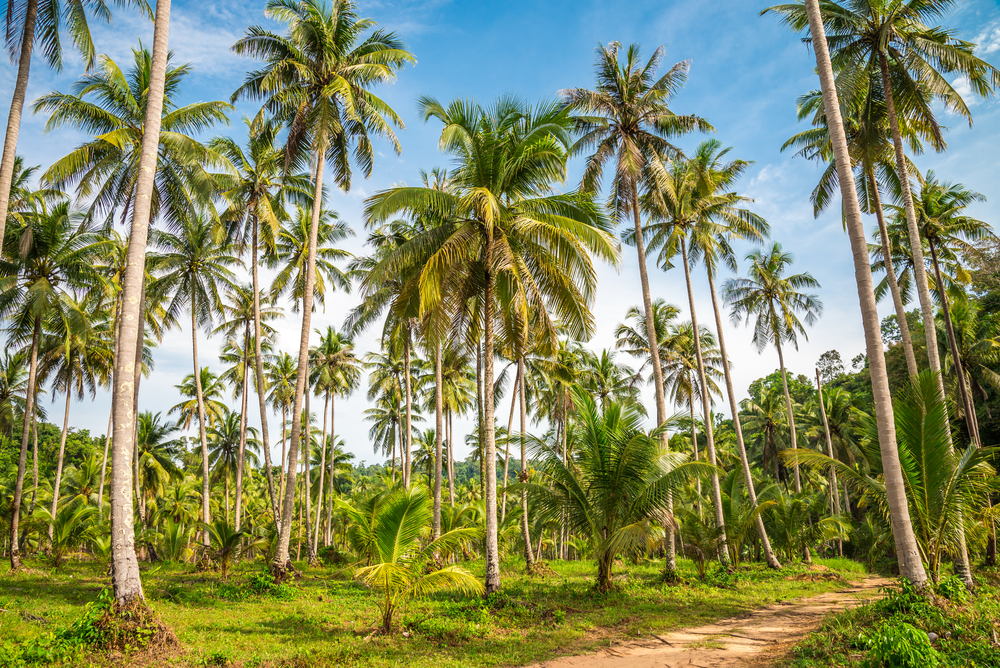
What Is a Coconut Tree?
The coconut palm is a flowering plant in the palm family Arecaceae. Palms are characterized by having a single, unbranched stem with large compound leaves called fronds. You can find them all over the world as they make up a large portion of the plants in many tropical and subtropical ecosystems.
There is only one species of coconut palm: Cocos nucifera. The species is ubiquitous among tropical beaches around the world, but it’s not entirely clear where the species originated. Coconut palms most likely came from Southeast Asia and Indonesia and were then distributed around the world by humans for cultivation.
The palms have been cultivated for hundreds of years (at least) for their edible fruit, and now there are many different varieties and hybrid coconuts. They can be separated into tall and dwarf varieties, but before we go into the different types of coconuts, let’s go over what makes the coconut fruit so special!
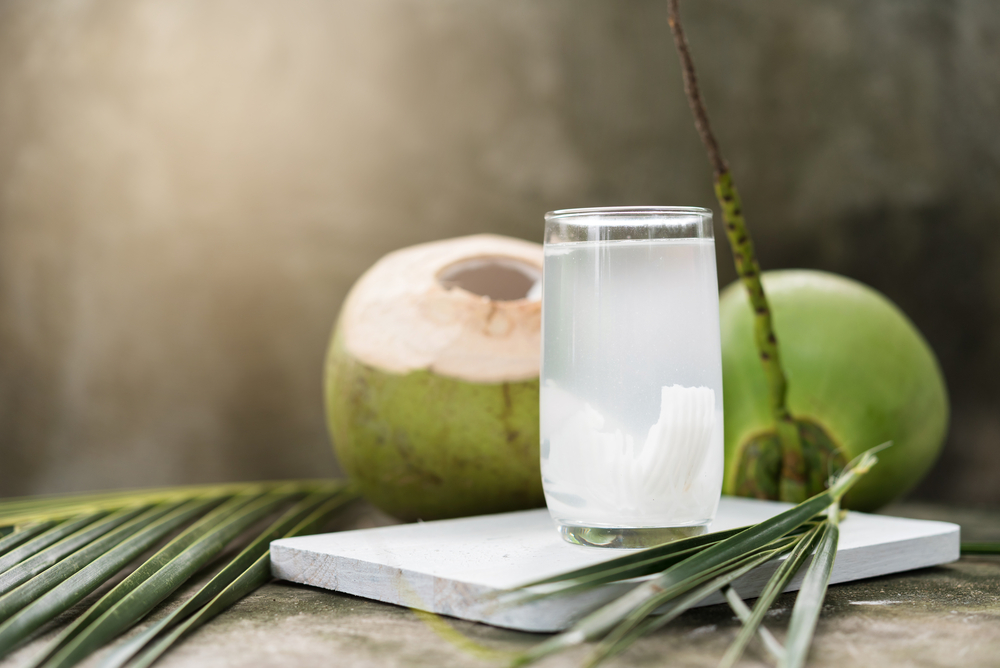
Health Benefits of Coconuts
Coconuts can be used in a variety of ways and provide many different health benefits. Botanically speaking, the coconut fruit is a type of drupe, which is any fruit containing one large seed. In the case of a coconut, the seed is huge, round, brown, and rock hard. You may be familiar with the seed’s durability if you’ve ever tried to open one.
One of the most incredible products of the fruit is coconut water. The clear liquid is slightly sweet and incredibly refreshing. It has tons of nutrients too, so it’s a great alternative to regular water.
Coconut meat is the white fleshy substance found inside the hard shell of a coconut. Ripe coconuts have harder meat while young coconuts have smooth, soft meat. Regardless of ripeness, coconut meat contains all sorts of beneficial fats and oils that can boost your immune system, help control weight loss, and reduce blood sugar, among other things.
Coconut oil and coconut milk are both derived from the meat of the coconut. Coconut oil is an excellent alternative to other cooking oil like olive or canola oil. Coconut milk has a rich, sweet taste and is a common ingredient in Asian dishes like curries.
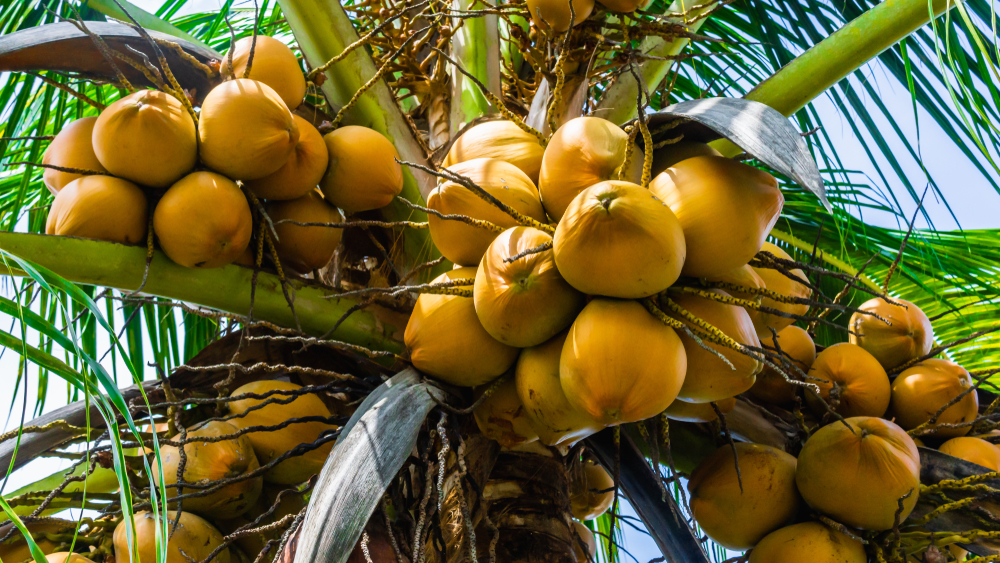
Different Types of Coconuts
There are many different types of coconut palms and their fruit can be green, orange, or brown. The different colors of coconuts depend on the ripeness. Green coconuts, which are unripe, have much more coconut water, while brown coconuts have much more meat. The following list contains info for 15 different types of coconuts, so keep reading to learn all about different coconut varieties!
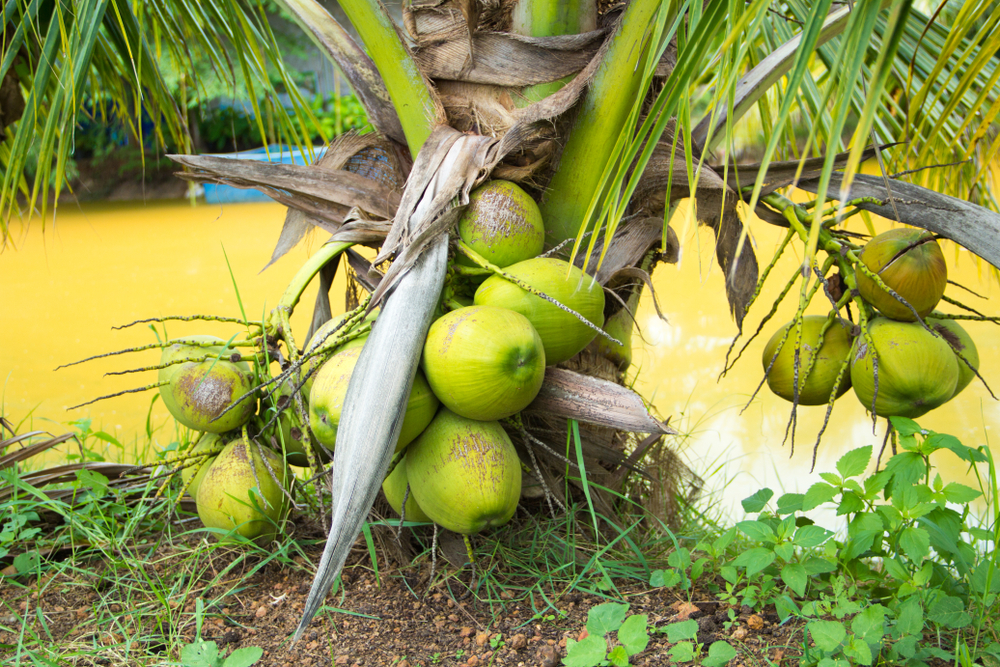
Dwarf Coconut Palms
Dwarf coconut palms are typically small in stature. They start producing fruit at a small age and size. Sometimes it only takes a few years for a dwarf variety to produce coconuts, at which point it may only be a meter or two tall. Even though dwarf coconuts can produce fruit when they are still a small size, some types can still grow to be quite tall.
Chowghat Orange Dwarf Coconut
Mature Size: 5 meters (16 feet)
Origin: Kerala, India
Sun, Soil, and Water Needs: Full sun, well-drained soil, and medium water.
Special Features: This variety produces coconuts after 3 or 4 years, and lives around 50 years on average. It’s famous for producing huge orange coconuts, up to 65 per year! The coconuts themselves have a large amount of meat and sweet water. This variety is one of the more popular ones due to the size of the coconuts and the amount of edible goodness they contain.
Malayan Yellow Dwarf Coconut Trees
Mature Size: 10-20 meters (30-60 feet)
Origin: Malaysia
Sun, Soil, and Water Needs: Full sun, well-drained soil, and drought tolerant.
Special Features: The Malayan yellow dwarf is one of the older varieties, originally cultivated in the late 1800s. It is fairly easy to grow and produces medium-sized yellow coconuts after just a few years of age. These days, the Malayan yellow dwarf coconut can be found in countries all over the world, especially Thailand, Brazil, and the Pacific Islands.
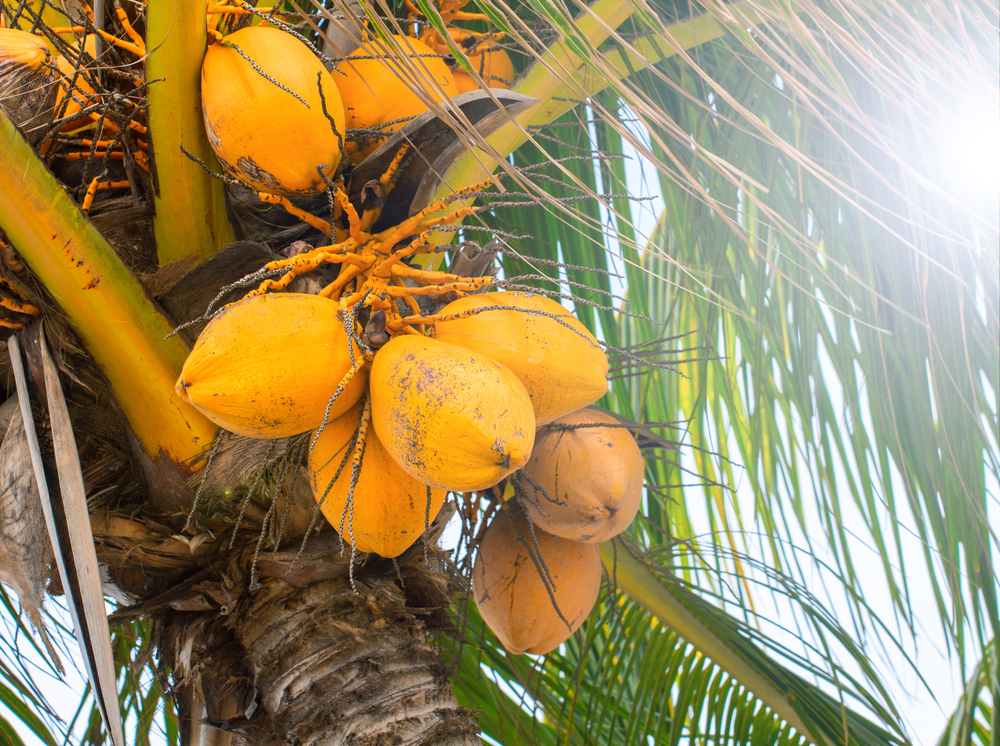
Golden Malayan Dwarf Coconut
Mature Size: 10-20 meters (30-60 feet)
Origin: Malaysia
Sun, Soil, and Water Needs: Full sun, well-drained soil, and drought tolerant.
Special Features: The golden Malayan dwarf coconut is the same as the yellow Malayan dwarf coconut in pretty much every way, except for the color. This variety produces dark orange coconuts instead of yellow, and they’re slightly larger, too.
Green Dwarf Coconut
Mature Size: 10 meters (30 feet)
Origin: Malaysia
Sun, Soil, and Water Needs: Full sun, well-drained soil, and drought tolerant.
Special Features: The green dwarf is another type of Malayan dwarf coconut, and like the two previous types, it is fairly easy to grow. This variety produces green coconuts that don’t ever turn yellow or gold. The tree itself also doesn’t grow as tall as the other Malayan varieties, and the coconuts typically contain more water and less meat.
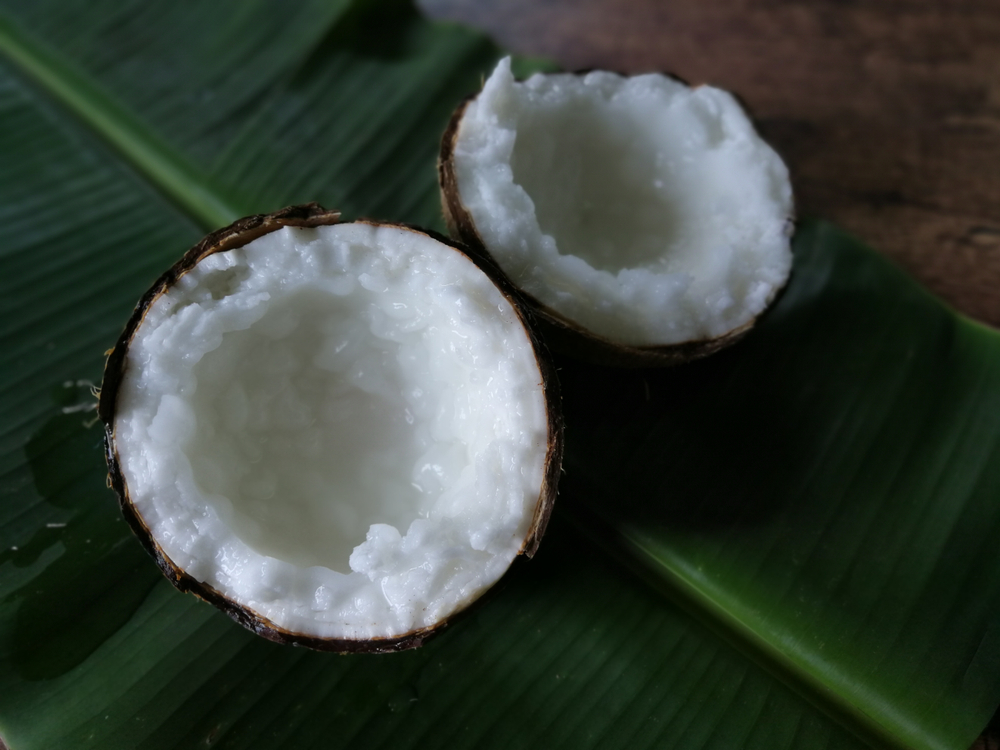
Macapuno Coconut
Mature Size: 5 meters (16 feet)
Origin: The Philippines
Sun, Soil, and Water Needs: Full sun, well-drained soil, and medium moisture.
Special Features: The Macapuno coconut is a variety that was caused by a genetic mutation in the 1930s. The mutation causes the endosperm of the fruit to develop abnormally, which leads to the coconut having almost no water. Instead, the coconut has meat that is incredibly soft, juicy, and sweet, making it a perfect type of coconut to use in desserts and pastries. Ever since the mutation occurred, people have cultivated the Macapuno variety for its decadent coconuts.
Fiji Dwarf
Mature Size: 8 meters (25 feet)
Origin: Fiji
Sun, Soil, and Water Needs: Full sun, well-drained soil, and medium moisture.
Special Features: In the 1970s, tall coconut varieties in Florida and the Caribbean were victims of a deadly yellowing disease. In just a couple of decades, millions of coconut palms perished to the disease, so a replacement variety was in dire need. The Fiji dwarf coconut turned out to be resistant to the deadly pathogen, so it was subsequently planted all throughout Caribbean countries as well as Florida.
The Fiji dwarf coconut produces fruit at a young age and height, so coconuts are able to be harvested without the use of a ladder. In addition, this variety has many leaves compacted at the top, making it appear more vibrant and lush than other varieties.
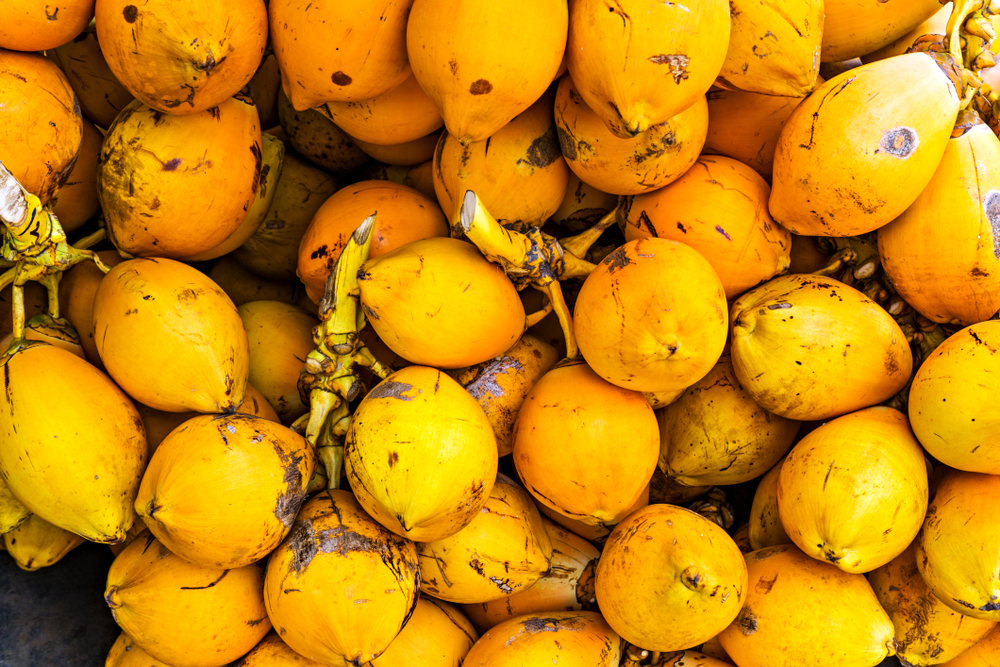
King Coconut
Mature Size: 10 meters (30 feet)
Origin: Sri Lanka
Sun, Soil, and Water Needs: Full sun, well-drained soil, and medium moisture.
Special Features: King coconuts are common along roads in Sri Lanka and southern India and are a common part of the diet for people in these countries. The coconuts themselves have an attractive shiny orange husk, and also contain more water than other varieties of coconut. The high sugar content in King coconuts makes them decadent and refreshing sources of hydration.
VHC1 Coconut
Mature Size:
Origin: Tamil Nadu, India
Special Features: The VHC1 coconut is a hybrid between the East Coast Tall and the Green dwarf coconut. It is famous for producing a massive amount of coconuts each year, up to 100 per tree!
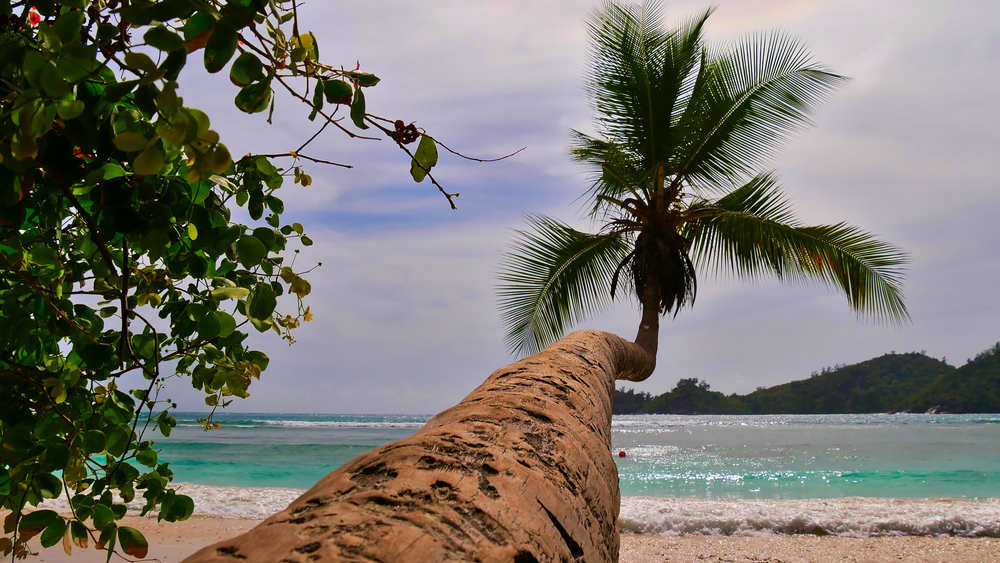
Tall Varieties of Coconuts
Tall coconuts are varieties that don’t produce as early on as the dwarf varieties. As their name suggests, they grow to a larger size before producing coconuts, and some can reach incredible heights at maturity. In addition, tall coconut varieties are typically live longer and are hardier than dwarf varieties.
East Coast Tall Coconut Tree
Mature Size: 30 meters (90 feet)
Sun, Soil, and Water Needs: Full sun, well-drained soil, and medium moisture.
Special Features: The east coast tall coconut is one of the more common types of cultivated coconuts. It is typically very hardy as long as the soil isn’t too wet. These tall palms begin producing coconuts after 6 or 8 years and can produce 60-70 coconuts per year.
West Coast Tall Coconut
Mature Size: 33 meters (100 feet)
Sun, Soil, and Water Needs: Full sun, well-drained soil, and drought tolerant.
Special Features: The west coast tall coconut is one of the tallest varieties of the coconut palm. It is slightly taller than the east coast tall variety and produces slightly more coconuts per year as well. In addition, the coconuts of the west coast tall coconut have a slightly higher oil content than most other types.
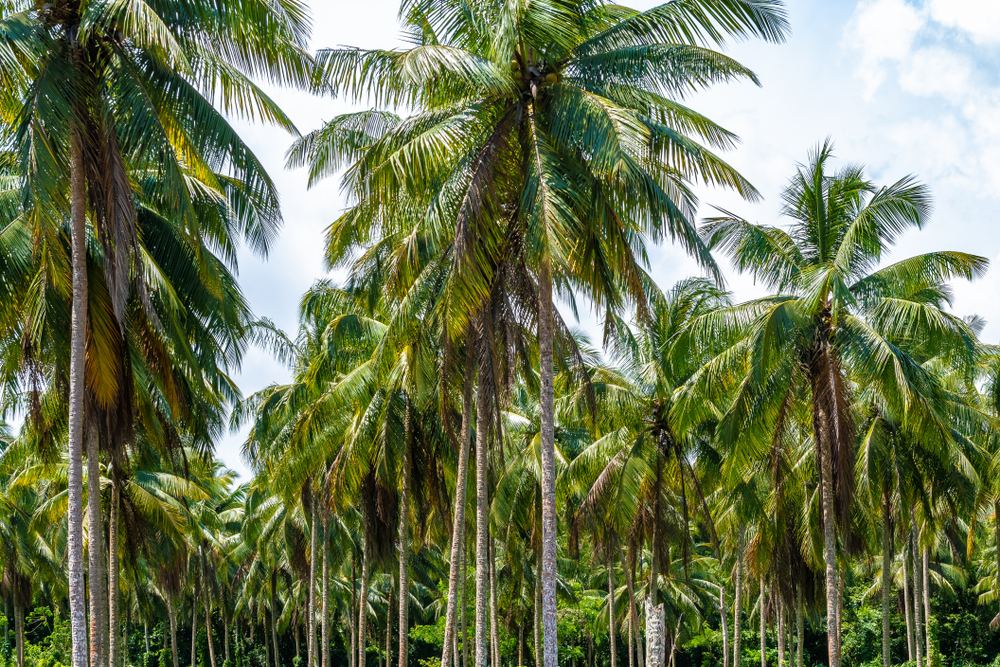
Jamaican Tall
Mature Size: 33 meters (100 feet)
Origin: Jamaica
Sun, Soil, and Water Needs: Full sun, well-drained soil, and medium to high moisture.
Special Features: The Jamaican tall is a beautiful, fast-growing, coconut palm that can live up to 80 years old. Its canopy is dense and globose, forming a round cluster of huge, dark green leaves. The trunk of the Jamaican tall is usually swollen at the base and is quite distinct. It also produces coconuts prolifically – up to 200 per year!
Panama Tall
Mature Size: 30 meters (90 feet)
Sun, Soil, and Water Needs: Full sun, well-drained soil, and medium moisture.
Special Features: The Panama tall, also called Pacific tall, is famous for its hardiness. The palm is especially resistant to wind, and it the most cold-resistant coconut palm there is. The Panama tall is a perfect choice for people in places with frequent storms, or in the subtropics where temperatures often drop below 60 or 70 degrees F. Its appearance is very similar to the Jamaican tall, but the Panama tall tends to have a more umbrella-shaped canopy rather than a round one.
Maypan Coconut
Mature Size: 20 meters (60 feet)
Origin: Jamaica
Sun, Soil, and Water Needs: Full sun, well-drained soil, and medium moisture.
Special Features: The Maypan coconut is another hybrid coconut that was cultivated in response to a lethal yellowing disease. The disease threatened to wipe out coconuts throughout the Caribbean, but like the Fiji dwarf, the Maypan coconut showed a resistance to the disease. This hybrid is a mix between Malayan dwarf and Panama Tall coconuts. It boasts the hardiness of the Malayan dwarf and the weather resistance of the Panama Tall.
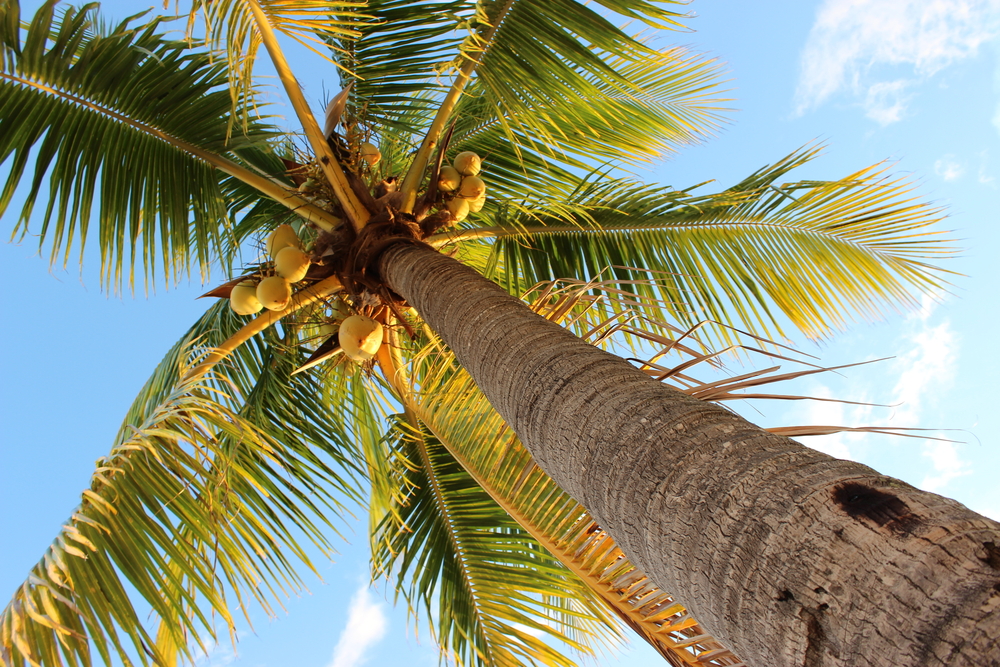
Tiptur Tall
Origin: India
Sun, Soil, and Water Needs: Full sun, well-drained soil, and medium moisture.
Special Features: The Tiptur tall coconut palm is one of the easiest to grow, requiring almost no maintenance once planted. It produces 70-80 coconuts per year and pushes out a reliable crop year after year.
Chandrakalpa Coconut
Origin: India
Sun, Soil, and Water Needs: Full sun, and tolerant of many different soils.
Special Features: The Chandrakapla coconut produces loads of coconuts – over 100 reliable coconuts each year! It can grow in many types of soil and is extremely tolerant of moisture, whether there is too much water or too little. It’s a good coconut variety to grow if you live in a place with severe rainy or dry seasons.
15 Types of Coconuts
There you have it: 15 different types of coconuts. Who knew there could be so many varieties of coconut palms, and that each one would have something particular to bring to the table? Coconuts are an awesome superfood, whether you like to eat coconut meat, drink coconut water, or use the oil to cook with. Now you can try to taste the differences between all the different types of coconuts!













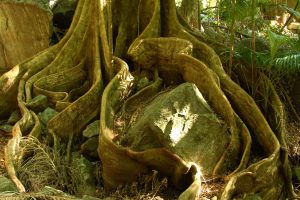

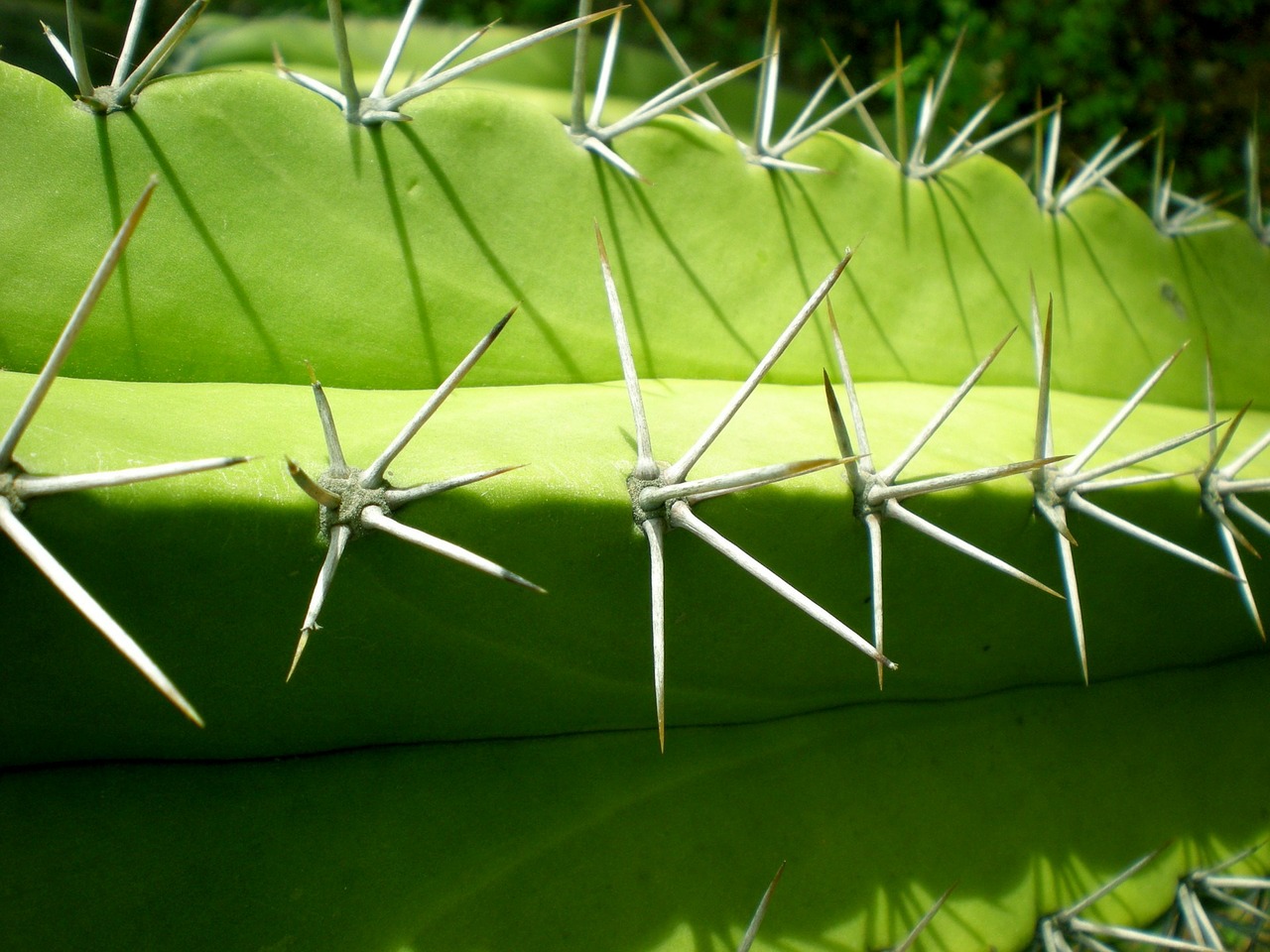
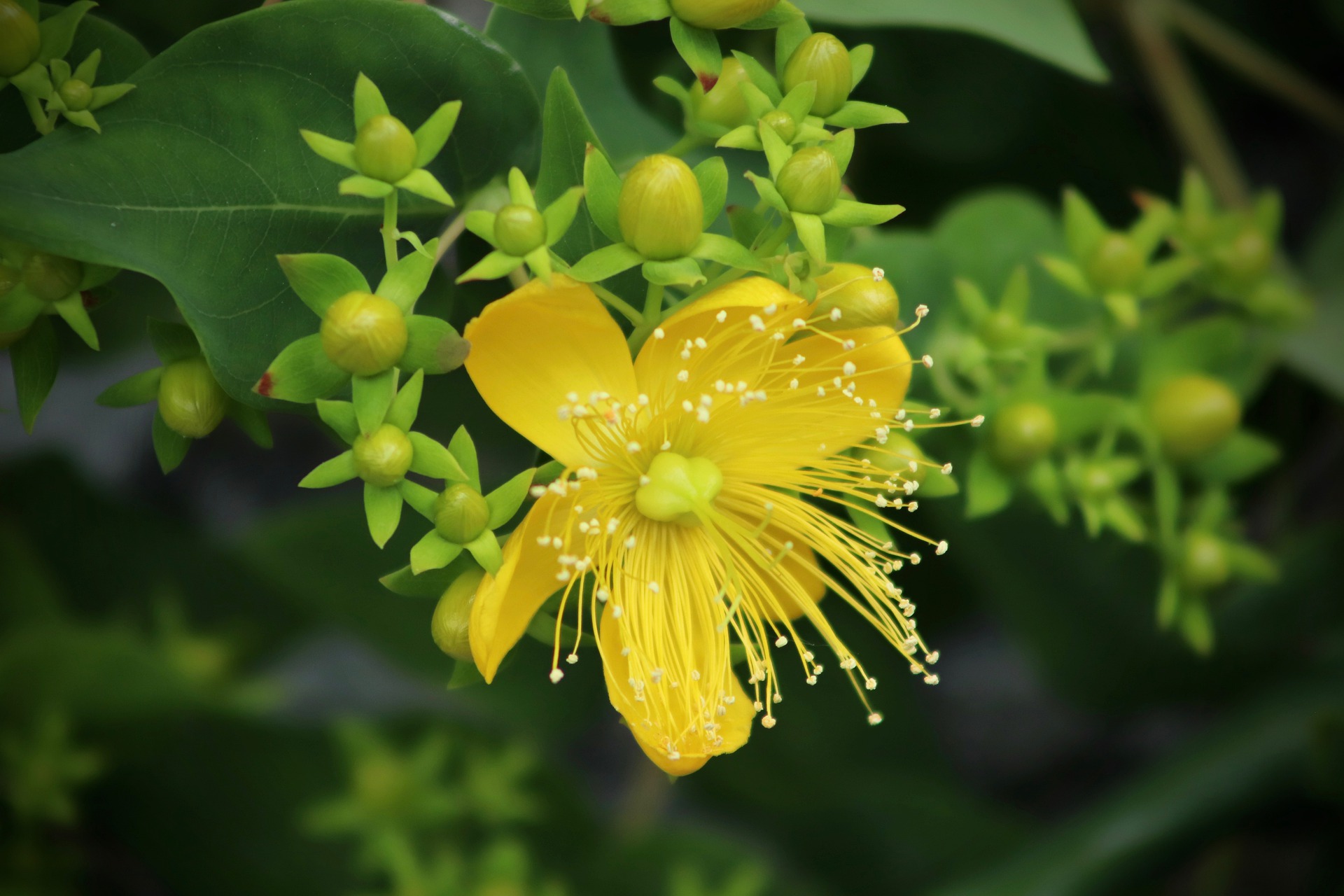
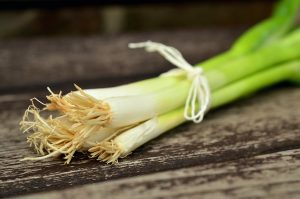
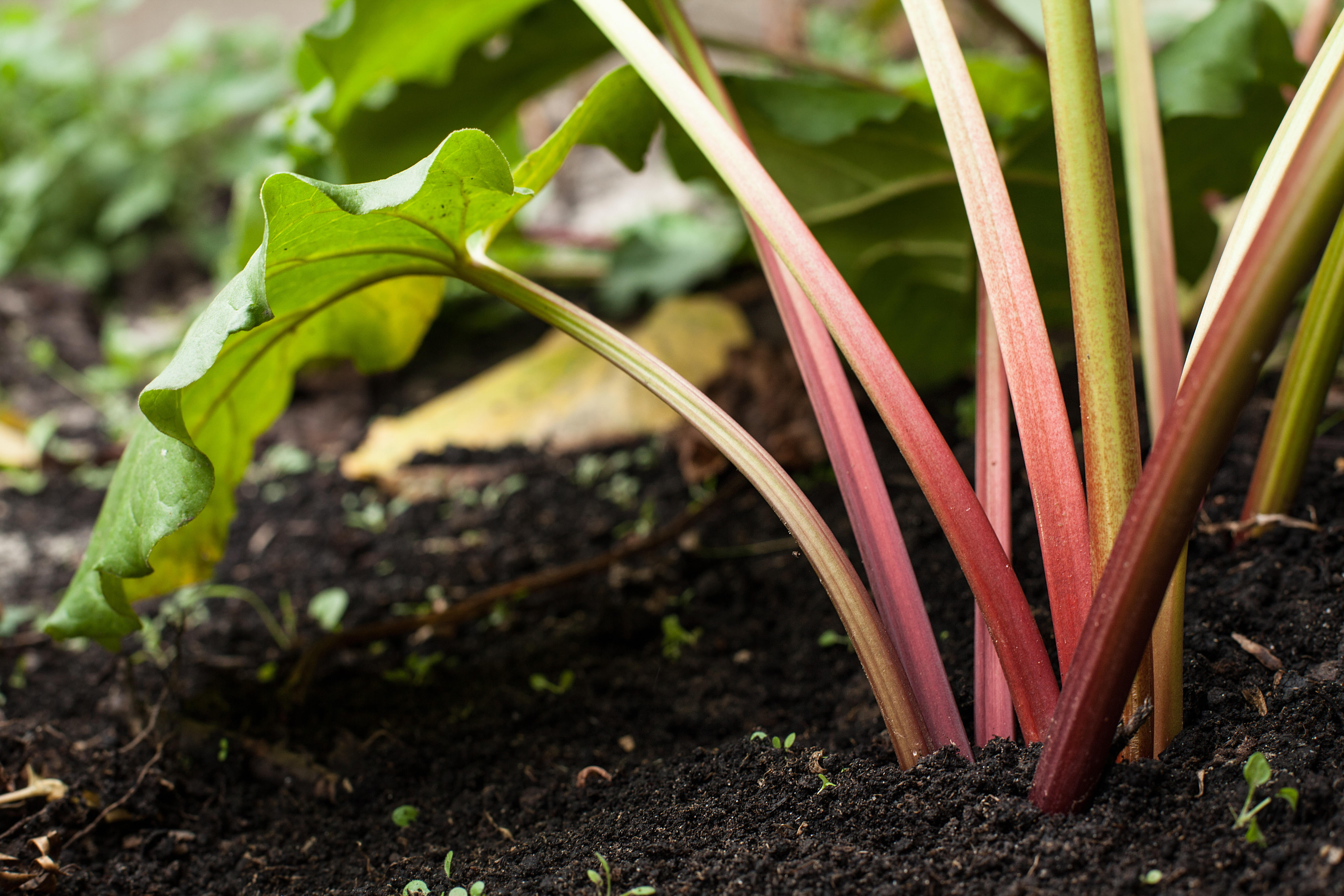

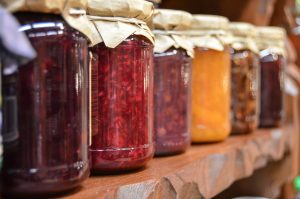

0 Comments